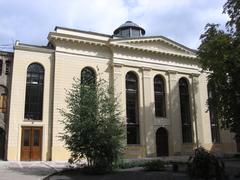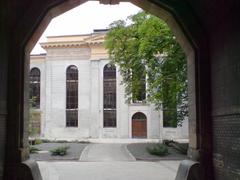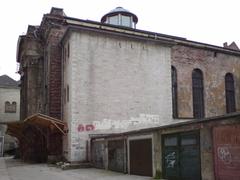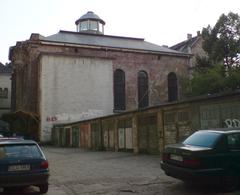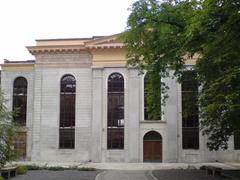
White Stork Synagogue Wrocław: Visiting Hours, Tickets, and In-Depth History Guide
Date: 14/06/2025
Introduction
The White Stork Synagogue (Synagoga Pod Białym Bocianem) stands at the heart of Wrocław, Poland, as a remarkable emblem of Jewish heritage, resilience, and architectural splendor. Erected in 1829 by the esteemed architect Carl Ferdinand Langhans—famed for his work on Berlin’s Brandenburg Gate—the synagogue’s neoclassical style and rich history reflect the aspirations and tribulations of one of Central Europe’s oldest Jewish communities. Today, it serves not only as a place of worship but also as a vibrant cultural center, hosting exhibitions, concerts, and interfaith events—a living testament to over 800 years of Jewish presence in Wrocław (fbk.org.pl; visitwroclaw.eu).
Situated in the unique Quarter of Four Denominations, the synagogue is surrounded by Catholic, Protestant, and Orthodox churches, symbolizing Wrocław’s tradition of religious coexistence. Surviving the horrors of Kristallnacht and Nazi occupation, the synagogue has undergone meticulous restoration, culminating in a vibrant hub for Jewish culture and education. This guide provides comprehensive information on the synagogue’s history, architecture, visiting hours, ticketing, accessibility, and practical travel tips—ensuring a rewarding experience for every visitor (zydowskiwroclaw.pl; samgrubersjewishartmonuments.blogspot.com; mikestravelguide.com; whitestorksynagogue.org).
Table of Contents
- Introduction
- History and Community Resilience
- Architecture and Artistic Features
- The Holocaust and Postwar Restoration
- Visiting Information: Hours, Tickets, Accessibility
- Guided Tours and Cultural Events
- Visitor Etiquette and Practical Advice
- Nearby Attractions and Suggested Itineraries
- Frequently Asked Questions (FAQ)
- Conclusion
- References and Further Reading
History and Community Resilience
Jewish Presence in Wrocław
Jewish life in Wrocław dates back to at least the early 13th century, with the community playing a key role in the city’s economic and cultural development. Despite enduring expulsions and persecution during the Middle Ages, the community flourished from the 18th century onward, particularly after the city became part of Prussia (aurora-israel.co.il). By the late 19th century, Wrocław (then Breslau) was home to one of the largest Jewish communities in Germany.
Synagogue Construction and Significance
The synagogue was conceived during the era of Jewish emancipation, designed by Carl Ferdinand Langhans in a restrained neoclassical style. Completed in 1829, it was named after the “White Stork” inn that once occupied the site (Wikipedia; jguideeurope.org). The building’s discreet courtyard location on ul. Włodkowica 7 reflected both the community’s hopes for integration and the realities of social vulnerability.
Throughout the 19th and early 20th centuries, the synagogue became the heart of Wrocław’s Jewish religious, cultural, and social life. It was associated with the rise of Reform and Conservative Judaism in Central Europe and featured essential facilities such as a mikveh and adjacent shul (zydowskiwroclaw.pl).
Architecture and Artistic Features
Exterior: Neoclassical Grandeur
The synagogue’s façade is a textbook example of neoclassical architecture, with symmetrical proportions, a prominent triangular pediment, and Ionic columns at the main entrance (samgrubersjewishartmonuments.blogspot.com). Its pale, stuccoed exterior stands out in the secluded courtyard, providing a sense of dignity and permanence (visitwroclaw.eu).
The semi-enclosed courtyard, historically used for gatherings, has been restored as a venue for festivals and outdoor events.
Interior: Sanctuary and Decorative Program
- Main Sanctuary: A large, light-filled hall designed to accommodate hundreds, with the bimah (reader’s platform) centrally placed and the Aron ha-Kodesh (Torah ark) at the eastern wall (samgrubersjewishartmonuments.blogspot.com).
- Women’s Galleries: Elevated galleries (matronea) for women, supported by Neo-Romantic balustrades, added during a 1905 renovation (visitwroclaw.eu).
- Art Nouveau Elements: Early 20th-century updates introduced ornate stucco, floral motifs, and decorative moldings, blending neoclassical structure with Art Nouveau exuberance (synagogues-360.anumuseum.org.il).
- Stained Glass: Restored windows feature Jewish symbols and abstract patterns, filtering colored light into the sanctuary (evendo.com).
- Aron ha-Kodesh & Bimah: Both focal points were meticulously reconstructed in the 21st-century restoration, featuring gilded details and Hebrew inscriptions (samgrubersjewishartmonuments.blogspot.com).
The Holocaust and Postwar Restoration
World War II and the Synagogue’s Survival
During Kristallnacht in 1938, most synagogues in Wrocław were destroyed. The White Stork Synagogue survived because its location deterred arson (jguideeurope.org). The Nazis desecrated and repurposed it as a warehouse and deportation gathering point.
Postwar Decline and Revitalization
After World War II, the synagogue fell into disrepair and suffered acts of vandalism. Systematic restoration began in 1996, led by the Jewish Community of Wrocław and the Bente Kahan Foundation, culminating in 2010. The project restored structural integrity, recreated lost decorative elements, and adapted the building for modern cultural functions (visitwroclaw.eu; samgrubersjewishartmonuments.blogspot.com).
Visiting Information: Hours, Tickets, Accessibility
Opening Hours
- Tuesday to Sunday: 10:00 AM – 6:00 PM
- Closed: Mondays, major Jewish holidays, and during religious services or special events. Always verify the current schedule on the official website.
Ticket Prices
- Adults: 15 PLN
- Students/Seniors: 10 PLN
- Children under 7: Free
Tickets can be purchased on-site or reserved online. Group and guided tour reservations are recommended, especially during peak seasons.
Accessibility
- Wheelchair access: Ramps and elevators are provided.
- Assistive listening devices: Available for guided tours.
- Restrooms and facilities: On-site restrooms and a gift shop are available.
Guided Tours and Cultural Events
Guided tours are offered in Polish, English, and German, providing in-depth historical and architectural context. Tours are typically available at 11:00 AM and 3:00 PM but can be arranged for groups at other times (whitestorksynagogue.org). Educational workshops and cultural programs—including music concerts, exhibitions, and the annual Simcha Jewish Culture Festival—make the synagogue a dynamic community hub (fbk.org.pl).
Visitor Etiquette and Practical Advice
- Dress code: Modest attire is recommended; shoulders and knees should be covered.
- Photography: Allowed without flash; videography may require prior permission. Restrictions apply during ceremonies.
- Respectful behavior: Silence or quiet conversation is expected in prayer areas; mobile phones should be silenced.
- Arrival: Arrive a few minutes before your scheduled tour or event.
- Security: Bag checks may be conducted at entry.
Nearby Attractions and Suggested Itineraries
The synagogue’s central location makes it easy to explore other Wrocław landmarks:
- Old Jewish Cemetery: A poignant memorial and historical site (mikestravelguide.com).
- Wrocław Market Square & Old Town Hall: Architectural gems and vibrant city life.
- District of Four Denominations: Catholic, Lutheran, and Orthodox churches in close proximity, highlighting the city’s multicultural spirit.
A typical visit to the synagogue lasts 1–2 hours. Consider joining a half-day Jewish heritage walking tour to include the cemetery and other key sites (Mike’s Travel Guide).
Frequently Asked Questions (FAQ)
Q: What are the visiting hours?
A: Tuesday to Sunday, 10:00 AM to 6:00 PM; closed Mondays and Jewish holidays (whitestorksynagogue.org).
Q: How much are tickets?
A: 15 PLN for adults, 10 PLN for students and seniors, free for children under 7.
Q: Are guided tours available?
A: Yes, in multiple languages. Advance booking is recommended.
Q: Is the synagogue wheelchair accessible?
A: Yes, main areas are accessible; some upper galleries require stairs.
Q: Can I take photographs inside?
A: Yes, without flash; restrictions apply during ceremonies.
Conclusion
The White Stork Synagogue is more than a historical monument; it embodies the enduring spirit of Wrocław’s Jewish community and the city’s broader tradition of multiculturalism and resilience. Its neoclassical architecture, richly restored interiors, and dynamic cultural programming make it an essential destination for anyone interested in history, architecture, or cultural heritage. By planning your visit with the latest information, participating in guided tours, and exploring nearby attractions, you will gain deeper insight into the tapestry of Wrocław’s past and present.
For updated visiting hours, tickets, and event schedules, consult the official website. Enhance your trip with the Audiala app for immersive audio guides, tips, and event alerts.
Stay connected with us on social media for news, travel inspiration, and upcoming cultural events in Wrocław!
References and Further Reading
- White Stork Synagogue History – FBK
- White Stork Synagogue Restoration – VisitWroclaw.eu
- White Stork Synagogue Architecture – Sam Gruber’s Jewish Art Monuments Blog
- Jewish Community of Wrocław – Post-War Reconstruction
- Wrocław Jewish Heritage Tour – Mike’s Travel Guide
- White Stork Synagogue Official Website
- Lonely Planet: White Stork Synagogue, Wrocław
- Aurora Israel: History of the Jews of Wrocław

